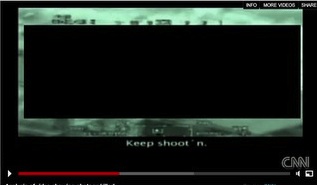08 Apr War crime – followup
The appalling Wikileaks video showing a US helicopter gunship mowing down a group of Iraqis, including two Reuters journalists, two children, and a pair of Good Samaritans whose only offense was to come to the aid of a badly injured man, continues to provoke reaction. Reader Cliff White writes:
You can’t help wondering after watching that terrible video if killing has just become a game to those soldiers in the helicopter. It’s both terribly disturbing and dismaying to listen to their casual banter as they go about their “work”. Even when they learn that children have been injured it’s no big deal, it’s someone else’s fault. I’d like to see videos like this publicly displayed every time war fever is on the rise in the country. The reality is that this kind of behaviour is not the exception in war, it is frequently the norm…. Given the situation in Iraq at the time the video was shot was it standard military practice to kill anyone carrying a weapon and anyone else who happen to be in their vicinity?
Two things are important here: While the behavior of the soldiers was shocking, it’s probably not unusual. As Cliff says, when we make the decision to go to war, we need to understand that this is exactly what we are deciding to do. Second, ultimate responsibility for this travesty lies beyond the helicopter, with the generals in the war rooms.
I have been shocked at the breadth of efforts to dismiss the video as somehow not reflecting reality, or evidence that liberals don’t support “our boys.” You expect this from right wing organs like the National Standard, where blogger Bill Roggio posted an error-riddled screed against Wikileaks, later nicely debunked by Salon.com’s Glenn Greenwald, who has been a one-man truth squad on the story. Among other things, Roggio and the New York Times chided Wikileaks for editing the tape, accusing them of redacting critical context. Wikileaks did edit the tape, but it simultaneously released the 39-minute original, completely unedited.
Greenwald’s coverage pointed me to a blogger called Jotman, who has relentlessly cataloged CNN’s cowardly coverage of the video (here, here, and here.) CNN won’t even show its viewers the most incriminating parts of the video. In a gesture reminiscent of Elvis Presley’s maiden appearance on the Ed Sullivan show, only far more sinister, Blitzer and Co. black out part of the screen when the shooting starts—all out of deference to the families of the victims, of course.
George Packer, a long time apologist for the war, pooh-poohs the video in, of all places, his New Yorker blog. The main thrust is that less worldly wise civilians fail to consider the context, fog of war, recent firefight, violent history of the neighborhood, blah, blah, blah, before condemning the soldiers’ actions. The blog is worth read both as an example of sophistry, and for the acuity of the New Yorker readers’ rebuttals.
The most apt response to this line of rationalization comes in a pair of unnamed readers’ comments to James Fallows’s blog yesterday.
First a question: If these loose rules of engagement were in common use in 2007, how do we explain the behavior of the victims? They were aware of the helicopter. Why didn’t they recognize their danger? [Ie, if it was commonplace for gunships to be shooting people with as little immediate provocation as we see, why did they dare expose themselves?]
Next, an observation: Door gunner-ship is not randomly assigned. It may well be that 99% (or 99.9%) of U.S. troops would not have allowed this tragedy to occur, but that simple fact quite possibly disqualified all those individuals from being in that position. (And I note this as a direct result of my Army tour in Viet Nam.) The same, of course, applies to Granger and gang at Abu Ghraib. It is possible to indict the individuals involved and their commanders and ‘the system’ without involving American troops categorically.
And a conclusion: Until one can say one would apply precisely the same reasoning and the same judgment without knowing the nationality of the miscreants, one flounders.
and:
You might — MIGHT — justify the initial attack on the group on the ground, but the American soldiers were itching to fire on the two men whose only crime was that they were trying to come to the aid of a wounded man. Those men in the van clearly did not have any weapons, and posed no threat to anyone. But the American soldiers were almost pleading with their command to be given permission to kill them. If you are going to excuse this by putting it into “context,” then you can excuse almost any behavior.

